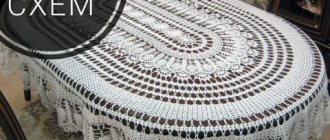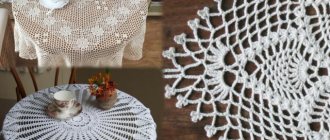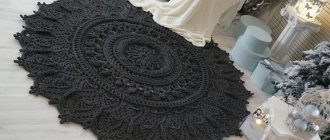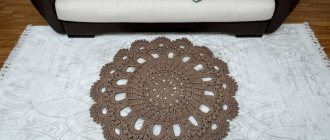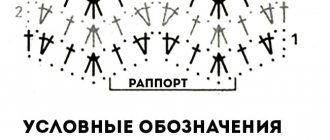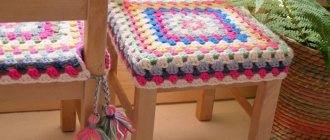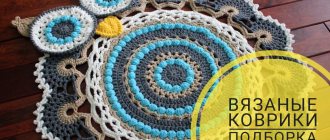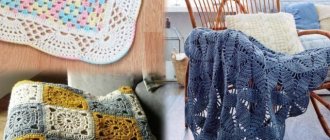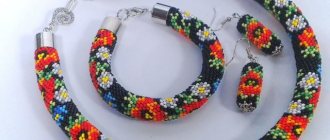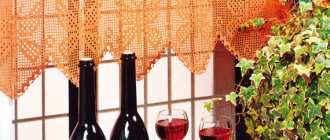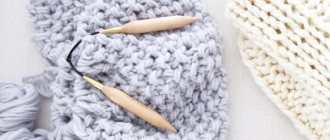Many years ago, crocheted items were present on almost every square meter in the house. And now on every street corner you can see a shop with a bunch of handicraft supplies. This means only one thing - the craft has returned. It has become fashionable to do handicrafts. Girls are happy to learn new techniques and share secrets with their friends. Knitted products for the home are especially valued. These are different decorative items and especially tablecloths. What lovely table covers you can make with crochet. What you need for this is patience, yarn and a hook. Below are a few mind-blowing patterns for knitting a beautiful tablecloth. And for those who have little understanding of crochet patterns, detailed master classes on how to make a simple model and a more complex product at home.
How to calculate the size of a tablecloth for a rectangular table
A very interesting question regarding the size of the tablecloth. They are all different, and each has its own allowance. In fact, calculating the size is very simple; you just need to measure the length and width of this table, and then add an allowance to each measurement, which is multiplied by 2. Following the rule of good manners, further details about the allowance itself.
- Allowance for everyday wear. For every day tablecloth or just a home option - this is not too drooping. For it, the allowance is used in the range of 15–20 cm. This length is convenient to use.
- For the holidays. This model is designed for a holiday at home. Here it’s worth covering the table legs a little more than for everyday use. The allowance for this option will be in the range of 20–30 cm.
- Wedding, official reception and banquet. A significant event and for such events the model should hang 40 cm from the edge.
- Buffet serving. In the case of a buffet table, the table legs should not be visible at all, and therefore the tablecloth should be level with the floor. Therefore, you should also measure the height of the table.
Following the rules of good manners, you can knit several tablecloths for different occasions. And use them as the celebration approaches.
Important! Based on the required allowance, you need to cast on the correct number of loops and knit as many repeats in height as the dimensions require. This must be done according to the density of the knitting.
A sample will help determine the tightness of the knitting.
These are several reports (a small square or a small motif), where everything is created based on the model’s pattern. Then insert a ruler and count how many (columns and other elements) 10 cm can fit horizontally and vertically. Two numbers will make up the knitting density. Simple mathematics will help you convert all measurements into loops. Let's create an equation with an unknown variable and solve it by proportion. x - number of loops in the set;
a - cm for set;
c - loops 10 cm;
s - 10 cm.
x = (ab)/s.
Mini tablecloth made of motifs
You can call it a tablecloth, or you can call it a napkin. It fits perfectly on a coffee table, chest of drawers, or coffee table. In the picture the tablecloth is pink, but you can choose the color based on your imagination.
So, what we need to have: Barroco Maxcolor 4/8 cotton yarn and a hook with the corresponding number. The size of this tablecloth is 75 by 75 cm.
You need to knit from 9 square modules 3 by 3 cm in dense knitting. Then they connect. How to create a square module can be seen in the figure.
Selection of patterns for crochet tablecloths on a rectangular table
Finding patterns for tablecloths is also time-consuming. Now you don’t have to waste it, because below are the coolest patterns from the search for creating a rectangular tablecloth. It’s also convenient that they are all divided into categories for beginners and slightly more complex models. And a new branch is a category for making a decorative element for a tablecloth. A simple canvas would be boring without a little embellishment to add to one of the dangling edges.
Schemes for beginners
A very simple pattern of double crochets, chain stitches and single crochets. The result is a canvas with small flowers and something very reminiscent of a net.
Next are three patterns from the fillet mesh category with very beautiful patterns of flowers and leaves.
A simple diagram with petals.
Another simple version of fillet knitting.
The last model is more complex, with a border and different elements for it. These patterns are suitable for a beginner, as the patterns are not very complex and do not require constant counting of stitches. Behind the mesh comes a flower, followed by a simple mesh again.
Interesting patterns for crocheting a tablecloth
Very beautiful models can be made according to the diagrams below.
An interesting scheme with rectangular motifs.
Quite a thick tablecloth made of double crochets.
Openwork tablecloth with cones.
Pattern for knitting items with a large hem.
Scheme with a flower of 4 petals.
Thick tablecloth with interesting patterns.
These patterns require crocheting skills. But if a beginner believes in his abilities, then why not try his hand at making rather unusual models for the table.
Knitting patterns for decorative elements for tablecloths
It's not just the border that helps complement the tablecloth. A little decor will help make it less boring. let it be a tiny heart and the tablecloth will no longer be the same as everyone else’s.
And what charming flowers can be made using the given patterns. Very nice. Shouldn't the resulting tablecloth be cute and warm?
Variant of knitting daisies.
Volumetric rose made of threads.
Selection of materials
Now let's decide on the material and hooks. For knitting tablecloths for everyday use, synthetic yarn is best suited; it should be uniform, dense and durable, then your product will last a long time and will not lose its appearance. To create a festive product, you can choose yarn from linen and cotton. Well, the main tool of a knitter is a hook. The hook must exactly match the thickness of the yarn. We need to know its size and length.
Related article: Do-it-yourself family tree from palms: master class with photos
Hooks vary in plastic, wood, aluminum, steel and even bone.
The following figure shows a table of hook sizes corresponding to different types of threads.
Note! The head of the hook should not be very sharp or round; the hook itself should be smooth.
Having decided on the tool, you can start working. Let's start with a mini tablecloth, which consists of square pieces (modules or motifs).
How to knit a simple tablecloth on a rectangular table step by step
A very beautiful and very simple tablecloth with birds for a rectangular table. The model was made using a simple fillet mesh with a simple fabric pattern.
To work you will need:
- iris yarn approximately 200 g;
- hook number 0.85.
The size of the product will be 100 x 60 cm.
Stage: set . Crochet 366 chain stitches.
1st row: knit 1 dc in the 9th loop and so you get the first square, * 2 chain loops, double crochet in the 3rd and continue such squares until the end of the row. The work is done using the fillet knitting technique. Knit the completed squares of the pattern using double crochets.
Stage: border . Only 4 rows were used for tying and they are presented in the diagram.
Stage: drying. To get a flat and very even product, you need to wet a towel and spread the finished work, place the towel on top and wait until it dries completely. Then iron with an iron.
Recommendations from needlewomen
It is worth considering several points recommended for these products. Before starting work, you need to carefully prepare for it and thoroughly study the diagram. This will help avoid various troubles that may arise during mating.
Such tablecloths should not be washed in washing machines, but washed by hand, using gentle products for delicate fabrics.
When the main fabric is dried so that it does not change shape, you can secure it with pins.
If, when choosing a product option, you cannot give preference to types of knitting, then you can knit various motifs that can be fastened at will and given the product a different shape.
It is always worth remembering that original and high-quality tablecloths attract the eye. Therefore, you need to try while working and put a piece of your soul into the product.
Stunningly beautiful oval napkins
I personally like all oval-shaped napkins; there are a lot of patterns on the blog. But I would especially like to highlight this one among others. How graceful and tender she is! It has such a magnificent combination of a pattern of roses with fillet knitting, mesh and a simple border. The approximate size, as stated in the magazine where I saw it, should have been 30 x 37 cm.
But after this post came out, I knitted this model and it turned out to be very large: 89 x 52 cm.
You should start from the central part of the loin from its lower side, casting on 43 loops. Next comes step knitting.
And then arches are added to this finished part and further knitting occurs in the round (Diagram 2).
And this is my embodiment of the “Phoenix” embossed napkin, the design of which was changed by Victoria Gul so that it becomes so textured. I already showed you this idea in a publication about embossed napkins, and there is also a diagram there. You can find the video master class on my channel if you wish.
What is fillet knitting technique?
Products made using fillet knitting technology, although visually similar to traditional lace, in fact are not.
Note! Despite all the external similarity, products made using the mesh knitting method are more practical than the thinnest original.
Filet knitting is similar to net embroidery.
This knitting is done by crochet. The style originated as an imitation of embroidery with the same name (embroidery on a grid). Often technologies are successfully combined in one product, and it looks very elegant.
In knitting, patterned cells are knitted together with the mesh immediately, and not as is done when simulating lace fillet (by sewing patterns onto the mesh fabric). The crocheted grid alternates filled and empty cells.
